Exploring the Potential of siRNA Delivery in Acute Myeloid Leukemia for Therapeutic Silencing
Abstract
1. Introduction
2. Materials and Methods
2.1. Materials
2.2. Cell Culture
2.3. Synthesis of Lipid-Modified PEIs

2.4. siRNA Delivery
2.5. Analysis of Cellular Proliferation
2.6. Apoptosis Analysis
2.7. mRNA Down-Regulation
2.8. Statistical Analysis
3. Results
3.1. Selection of Carriers for siRNA Delivery in Cell Lines
3.2. Growth Inhibition by siRNA Delivery in Cell Lines
3.3. mRNA Silencing and Apoptosis in KG1a and KG1 Cells
3.4. siRNA Delivery and Silencing in AML Patient Cells
4. Discussion
5. Conclusions
Supplementary Materials
Author Contributions
Funding
Data Availability Statement
Acknowledgments
Conflicts of Interest
References
- Estey, E.; Döhner, H. Acute myeloid leukaemia. Lancet 2006, 368, 1894–1907. [Google Scholar] [CrossRef]
- Abelson, S.; Collord, G.; Ng, S.W.K.; Weissbrod, O.; Mendelson Cohen, N.; Niemeyer, E.; Shlush, L.I. Prediction of acute myeloid leukaemia risk in healthy individuals. Nature 2018, 559, 400–404. [Google Scholar] [CrossRef] [PubMed]
- Gallipoli, P.; Giotopoulos, G.; Huntly, B.J.P. Epigenetic regulators as promising therapeutic targets in acute myeloid leukemia. Ther. Adv. Hematol. 2015, 6, 103–119. [Google Scholar] [CrossRef] [PubMed]
- Grimwade, D.; Ivey, A.; Huntly, B.J.P. Molecular landscape of acute myeloid leukemia in younger adults and its clinical relevance. Blood 2016, 127, 29–41. [Google Scholar] [CrossRef] [PubMed]
- Papaemmanuil, E.; Gerstung, M.; Bullinger, L.; Gaidzik, V.; Paschka, P.; Roberts, N.D.; Potter, N.E.; Heuser, M.; Thol, F.; Bolli, N.; et al. Genomic classification and prognosis in acute myeloid leukemia. N. Engl. J. Med. 2016, 374, 2209–2221. [Google Scholar] [CrossRef] [PubMed]
- Döhner, H.; Estey, E.; Grimwade, D.; Amadori, S.; Appelbaum, F.R.; Büchner, T.; Dombret, H.; Ebert, B.L.; Fenaux, P.; Larson, R.A.; et al. Diagnosis and management of AML in adults: 2017 ELN recommendations from an international expert panel. Blood 2016, 129, 424–447. [Google Scholar] [CrossRef] [PubMed]
- Lamble, A.; Kosaka, Y.; Lo, P.; Huang, F.; Sasser, K.; Tognon, C.E.; Loriaux, M.; Tyner, J.W.; Druker, B.J.; Lind, E.F. Defining the immune microenvironment in patients with acute myeloid leukemia. Blood 2015, 126, 1374. [Google Scholar] [CrossRef]
- Dombret, H.; Gardin, C. An update of current treatments for adult acute myeloid leukemia. Blood 2015, 127, 53–61. [Google Scholar] [CrossRef]
- Olsson, I.; Bergh, G.; Ehinger, M.; Gullberg, U. Cell differentiation in acute myeloid leukemia. Eur. J. Haematol. 1996, 57, 1–16. [Google Scholar] [CrossRef]
- Appelbaum, F.R.; Bernstein, I.D. Gemtuzumab ozogamicin for acute myeloid leukemia. Blood 2017, 130, 2373–2376. [Google Scholar] [CrossRef]
- Motyckova, G.; Stone, R.M. Development of midostaurin as a tyrosine kinase inhibitor. In Targeted Therapy of Acute Myeloid Leukemia; Springer: New York, NY, USA, 2015; Volume 2014, pp. 201–214. [Google Scholar]
- Stone, R.M.; Manley, P.W.; Larson, R.A.; Capdeville, R. Midostaurin: Its odyssey from discovery to approval for treating acute myeloid leukemia and advanced systemic mastocytosis. Blood Adv. 2018, 2, 444–453. [Google Scholar] [CrossRef] [PubMed]
- Rowe, J.M.; Löwenberg, B. Gemtuzumab ozogamicin in acute myeloid leukemia: A remarkable saga about an active drug. Blood 2013, 121, 4838–4841. [Google Scholar] [CrossRef] [PubMed]
- RPan, R.; Hogdal, L.J.; Benito, J.M.; Bucci, D.; Han, L.; Borthakur, G.; Cortes, J.; DeAngelo, D.J.; Debose, L.; Mu, H.; et al. Selective BCL-2 inhibition by ABT-199 causes on target cell death in acute myeloid leukemia. Cancer Discov. 2013, 4, 362–375. [Google Scholar]
- Kim, D.H.; Rossi, J.J. Strategies for silencing human disease using RNA interference. Nat. Rev. Genet. 2007, 8, 173–184. [Google Scholar] [CrossRef] [PubMed]
- Kaczmarek, J.C.; Kowalski, P.S.; Anderson, D.G. Advances in the delivery of RNA therapeutics: From concept to clinical reality. Genome Med. 2017, 9, 60. [Google Scholar] [CrossRef] [PubMed]
- Fire, A.; Xu, S.; Montgomery, M.K.; Kostas, S.A.; Driver, S.E.; Mello, C.C. Potent and specific genetic interference by double-stranded RNA in caenorhabditis elegans. Nature 1998, 391, 806. [Google Scholar] [CrossRef] [PubMed]
- Elbashir, S.M.; Harborth, J.; Lendeckel, W.; Yalcin, A.; Weber, K.; Tuschl, T. Duplexes of 21-nucleotide RNAs mediate RNA interference in cultured mammalian cells. Nature 2001, 411, 494. [Google Scholar] [CrossRef]
- Hannon, G.J. RNA interference. Nature 2002, 418, 244. [Google Scholar] [CrossRef]
- Imai, K.; Takaoka, A. Comparing antibody and small-molecule therapies for cancer. Nat. Rev. Cancer 2006, 6, 714–727. [Google Scholar] [CrossRef]
- Cioca, D.P.; Aoki, Y.; Kiyosawa, K. RNA interference is a functional pathway with therapeutic potential in human myeloid leukemia cell lines. Cancer Gene Ther. 2003, 10, 125. [Google Scholar] [CrossRef]
- Walters, D.K.; Stoffregen, E.P.; Heinrich, M.C.; Deininger, M.W.; Druker, B.J. RNAi-induced down-regulation of FLT3 expression in AML cell lines increases sensitivity to MLN518. Blood 2005, 105, 2952–2954. [Google Scholar] [CrossRef] [PubMed]
- Lostale-Seijo, I.; Montenegro, J. Synthetic materials at the forefront of gene delivery. Nat. Rev. Chem. 2018, 2, 258–277. [Google Scholar] [CrossRef]
- Wang, R.; Chow, T.Y.; Chen, S.; Ma, D.; Luo, T.; Tan, Y.; Dong, S. Magnetic force-driven in situ selective intracellular delivery. Sci. Rep. 2018, 8, 14205. [Google Scholar] [CrossRef] [PubMed]
- Merkerova, M.; Klamova, H.; Brdicka, R.; Bruchova, H. Targeting of gene expression by siRNA in CML primary cells. Mol. Biol. Rep. 2007, 34, 27. [Google Scholar] [CrossRef] [PubMed]
- Ansari, A.S.; Santerre, P.J.; Uludağ, H. Biomaterials for polynucleotide delivery to anchorage-independent cells. J. Mat. Chem. B 2017, 5, 7238–7261. [Google Scholar] [CrossRef] [PubMed]
- Basiouni, S.; Fuhrmann, H.; Schumann, J. High-efficiency transfection of suspension cell lines. BioTechniques 2012, 53, 1–4. [Google Scholar] [CrossRef] [PubMed]
- Pack, D.W.; Hoffman, A.S.; Pun, S.; Stayton, P.S. Design and development of polymers for gene delivery. Nat. Rev. Drug Discov. 2005, 4, 581. [Google Scholar] [CrossRef]
- Landry, B.; Aliabadi, H.M.; Samuel, A.; Gül-Uludağ, H.; Jiang, X.; Kutsch, O.; Uludağ, H. Effective non-viral delivery of siRNA to acute myeloid leukemia cells with lipid substituted polyethylenimines. PLoS ONE 2012, 7, e44197. [Google Scholar] [CrossRef]
- Behr, J. The proton sponge: A trick to enter cells the viruses did not exploit [Abstract]. CHIMIA Int. J. Chem. 1997, 51, 34–36. [Google Scholar] [CrossRef]
- Rehman, Z.U.; Hoekstra, D.; Zuhorn, I.S. Mechanism of polyplexand lipoplex-mediated delivery of nucleic acids: Real-time visualization of transient membrane destabilization without endosomal lysis. ACS Nano 2013, 7, 3767–3777. [Google Scholar] [CrossRef]
- [Guideline] NCCN Clinical Practice Guidelines in Oncology: Acute Myeloid Leukemia Version 1.2015. National Comprehensive Cancer Network. Available online: http://www.nccn.org/professionals/physician_gls/pdf/aml.pdf (accessed on 10 September 2018).
- Thapa, B.; KC, R.; Bahniuk, M.; Schmitke, J.; Hitt, M.; Lavasanifar, A.; Kutsch, O.; Seol, D.W.; Uludag, H. Breathing new life into TRAIL for breast cancer therapy: Co-delivery of pTRAIL and complementary siRNAs using lipopolymers. Hum. Gene Ther. 2019, 30, 1531–1546. [Google Scholar] [CrossRef] [PubMed]
- Thomadaki, H.; Floros, K.V.; Pavlovic, S.; Tosic, N.; Gourgiotis, D.; Colovic, M.; Scorilas, A. Overexpression of the novel member of the BCL2 gene family, BCL2L12, is associated with the disease outcome in patients with acute myeloid leukemia. Clin. Biochem. 2012, 45, 1362–1367. [Google Scholar] [CrossRef] [PubMed]
- Papageorgiou, S.G.; Kontos, C.K.; Pappa, V.; Thomadaki, H.; Kontsioti, F.; Dervenoulas, J.; Papageorgiou, E.; Economopoulos, T.; Scorilas, A. The novel member of the BCL2 gene family, BCL2L12, is substantially elevated in chronic lymphocytic leukemia patients, supporting its value as a significant biomarker. Oncol. 2011, 16, 1280–1291. [Google Scholar] [CrossRef] [PubMed][Green Version]
- Altieri, D.C. Survivin—The inconvenient IAP. Sem. Cell Develop. Biol. 2016, 39, 91–96. [Google Scholar] [CrossRef] [PubMed]
- Carter, B.Z.; Qiu, Y.; Huang, X.; Diao, L.; Zhang, N.; Coombes, K.R.; Mak, D.H.; Konopleva, M.; Cortes, J.; Kantarjian, H.M.; et al. Survivin is highly expressed in CD34+38− leukemic stem/progenitor cells and predicts poor clinical outcomes in AML. Blood 2012, 120, 173–180. [Google Scholar] [CrossRef]
- Carter, Z.B.; Milella, M.; Altieri, C.D.; Andreeff, M. Cytokine-regulated expression of survivin in myeloid leukemia. Blood 2001, 97, 2784–2790. [Google Scholar] [CrossRef]
- Small, S.; Keerthivasan, G.; Huang, Z.; Gurbuxani, S.; Crispino, J.D. Overexpression of survivin initiates hematologic malignancies in vivo. Leukemia 2010, 24, 1920–1926. [Google Scholar] [CrossRef]
- Remant, K.C.; Landry, B.; Aliabadi, H.M.; Lavasanifar, A.; Uludag, H. Lipid substitution on low molecular weight (0.6–2.0 kDa) polyethylenimine leads to a higher zeta potential of plasmid DNA and enhances transgene expression. Acta Biomater. 2011, 7, 2209–2217. [Google Scholar] [CrossRef]
- Parmar, M.B.; Arteaga, B.; Fu, T.; KC, B.; Aliabadi, H.M.; Hugh, J.C.; Löbenberg, R.; Uludağ, H. Multiple siRNA delivery against cell cycle and antiapoptosis proteins using lipid-substituted polyethylenimine in triple-negative breast cancer and non-malignant cells. J. Biomed. Mat. Res. A 2016, 104, 3031–3044. [Google Scholar] [CrossRef]
- Gul-Uludağ, H.D.; Valencia-Serna, J.; Kucharski, C.; Marquez-Curtis, L.A.; Jiang, X.; Larratt, L.M.; Janowska-Wieczorek, A.; Uludağ, H. Polymeric nanoparticle-mediated silencing of CD44 in CD34+ acute leukemia blasts. Leuk. Res. 2014, 11, 1299–1308. [Google Scholar] [CrossRef]
- Landry, B.; Gul-Uludağ, H.; Plianwong, S.; Kucharski, C.; Zak, Z.; Parmar, M.B.; Kutsch, O.; Jiang, H.; Brandwein, J.; Uludağ, H. Targeting CXCR4/SDF-1 axis by lipopolymer complexes of siRNA in acute myeloid leukemia. J. Control. Release 2016, 224, 8–21. [Google Scholar] [CrossRef] [PubMed]
- Aliabadi, H.M.; Bahadur, K.C.R.; Bousoik, E.; Hall, R.; Barbarino, A.; Thapa, B.; Coyle, M.; Mahdipoor, P.; Uludağ, H. A systematic comparison of lipopolymers for siRNA delivery to multiple breast cancer cell lines: In vitro studies. Acta Biomater. 2020, 102, 351–366. [Google Scholar] [CrossRef] [PubMed]
- Cheson, B.D.; Bennett, J.M.; Kopecky, K.J.; Büchner, T.; Willman, C.L.; Estey, E.H.; Schiffer, C.A.; Doehner, H.; Tallman, M.S.; Lister, T.A.; et al. Revised recommendations of the international working group for diagnosis, standardization of response criteria, treatment outcomes, and reporting standards for therapeutic trials in acute myeloid leukemia. J. Clin. Oncol. 2003, 21, 4642–4649. [Google Scholar] [CrossRef] [PubMed]
- Thol, F.; Schlenk, R.F.; Heuser, M.; Ganser, A. How I treat refractory and early relapsed acute myeloid leukemia. Blood 2015, 126, 319–327. [Google Scholar] [CrossRef] [PubMed]
- Puneet, A.; Ravi, B. Influence of bone marrow microenvironment on leukemic stem cells: Breaking up an intimate relationship. Adv. Cancer Res. 2015, 127, 227–252. [Google Scholar]
- Laverdière, I.; Boileau, M.; Neumann, A.L.; Frison, H.; Mitchell, A.; Ng, S.W.K.; Wang, J.C.Y.; Minden, M.D.; Eppert, K. Leukemic stem cell signatures identify novel therapeutics targeting acute myeloid leukemia. Blood Cancer J. 2018, 8, 52. [Google Scholar] [CrossRef]
- Quillet-Mary, A.; Mansat, V.; Duchayne, E.; Come, M.G.; Allouche, M.; Bailly, J.D.; Bordier, C.; Laurent, G. Daunorubicin-induced internucleosomal DNA fragmentation in acute myeloid cell lines. Leukemia 1996, 10, 417–425. [Google Scholar]
- Bailly, J.D.; Skladanowski, A.; Bettaieb, A.; Mansat, V.; Larsen, A.K.; Laurent, G. Natural resistance of acute myeloid leukemia cell lines to mitoxantrone is associated with lack of apoptosis. Leukemia 1997, 11, 1523–1532. [Google Scholar] [CrossRef]
- Bettaieb, A.; Record, M.; Côme, M.G.; Bras, A.C.; Chap, H.; Laurent, G.; Jaffrézou, J.P. Opposite effects of tumor necrosis factor alpha on the sphingomyelinceramide pathway in two myeloid leukemia cell lines: Role of transverse sphingomyelin distribution in the plasma membrane. Blood 1996, 88, 1465. [Google Scholar] [CrossRef]
- She, M.; Niu, X.; Chen, X.; Li, J.; Zhou, M.; He, Y.; Le, Y.; Guo, K. Resistance of leukemic stem-like cells in AML cell line KG1a to natural killer cell-mediated cytotoxicity. Cancer Lett. 2012, 318, 173–179. [Google Scholar] [CrossRef]
- McCarty, M.F.; DiNicolantonio, J.J. Lauric acid-rich medium-chain triglycerides can substitute for other oils in cooking applications and may have limited pathogenicity. Open Heart 2016, 3, e000467. [Google Scholar] [CrossRef] [PubMed]
- Lappano, R.; Sebastiani, A.; Cirillo, F.; Rigiracciolo, D.C.; Galli, G.R.; Curcio, R.; Malaguarnera, R.; Belfiore, A.; Cappello, A.R.; Maggiolini, M. The lauric acid-activated signaling prompts apoptosis in cancer cells. Cell Death Discov. 2017, 3, 17063. [Google Scholar] [CrossRef] [PubMed]
- Bulbake, U.; Doppalapudi, S.; Kommineni, N.; Khan, W. Liposomal formulations in clinical use: An updated review. Pharmaceutics 2017, 9, 12. [Google Scholar] [CrossRef] [PubMed]
- Meneksedag-Erol, D.; Tang, T.; Uludağ, H. Molecular modeling of polynucleotide complexes. Biomaterials 2014, 35, 7068–7076. [Google Scholar] [CrossRef] [PubMed]
- Bocca, C.; Bozzo, F.; Gabriel, L.; Miglietta, A. Conjugated linoleic acid inhibits caco-2 cell growth via ERK-MAPK signaling pathway. J. Nutr. Biochem. 2007, 18, 332–340. [Google Scholar] [CrossRef] [PubMed]
- Engelbrecht, A.; Toit-Kohn, J.; Ellis, B.; Thomas, M.; Nell, T.; Smith, R. Differential induction of apoptosis and inhibition of the PI3-kinase pathway by saturated, monounsaturated and polyunsaturated fatty acids in a colon cancer cell model. Apoptosis 2008, 13, 1368. [Google Scholar] [CrossRef]
- Lian, G.; Dettenhofer, M.; Lu, J.; Downing, M.; Chenn, A.; Wong, T.; Sheen, V. Filamin A- and formin 2-dependent endocytosis regulates proliferation via the canonical Wnt pathway. Development 2016, 143, 4509–4520. [Google Scholar] [CrossRef]
- Shojima, K.; Sato, A.; Hanaki, H.; Tsujimoto, I.; Nakamura, M.; Hattori, K.; Sato, Y.; Dohi, K.; Hirata, M.; Yamamoto, H.; et al. Wnt5a promotes cancer cell invasion and proliferation by receptor mediated endocytosis-dependent and -independent mechanisms, respectively. Sci. Rep. 2015, 5, 8042. [Google Scholar] [CrossRef]
- Caffrey, D.R.; Zhao, J.; Song, Z.; Schaffer, M.E.; Haney, S.A.; Subramanian, R.R.; Seymour, A.B.; Hughes, J.D. siRNA off-target effects can be reduced at concentrations that match their individual potency. PLoS ONE 2011, 6, e21503. [Google Scholar] [CrossRef]
- Khvorova, A.; Scaringe, S.; Boese, Q.; Leake, D.; Reynolds, A.; Marshall, W.S. Rational siRNA design for RNA interference. Nat. Biotechnol. 2004, 22, 326–330. [Google Scholar]
- Dar, S.A.; Thakur, A.; Qureshi, A.; Kumar, M. siRNAmod: A database of experimentally validated chemically modified siRNAs. Sci. Rep. 2016, 6, 20031. [Google Scholar] [CrossRef] [PubMed]
- Hemminki, K.; Dipple, A.; Shuker, D.E.G.; Kadlubar, F.F.; Bartsch, D.S.H. DNA Adducts: Identification and Biological Significance; IARC Scientific Publication 125; IARC: Lyon, France, 1994. [Google Scholar]
- Furgeson, D.Y.; Cohen, R.N.; Mahato, R.I.; Kim, S.W. Novel water insoluble lipoparticulates for gene delivery. Pharm. Res. 2002, 19, 382–390. [Google Scholar] [CrossRef] [PubMed]
- Brownlie, A.; Uchegbu, I.F.; Schätzlein, A.G. PEI-based vesicle-polymer hybrid gene delivery system with improved biocompatibility. Int. J. Pharm. 2004, 274, 41–52. [Google Scholar] [CrossRef] [PubMed]
- Hsu, C.Y.M.; Hendzel, M.; Uludag, H. Improved transfection efficiency of an aliphatic lipid substituted 2 kDa polyethylenimine is attributed to enhanced nuclear association and uptake in rat bone marrow stromal cell. J. Gene Med. 2011, 13, 46–59. [Google Scholar] [CrossRef]
- Valencia-Serna, J.; Gul-Uludağ, H.; Mahdipoor, P.; Jiang, X.; Uludağ, H. Investigating siRNA delivery to chronic myeloid leukemia K562 cells with lipophilic polymers for therapeutic BCR-ABL down-regulation. J. Control. Release 2019, 172, 495–503. [Google Scholar] [CrossRef]
- Edfors, F.; Danielsson, F.; Hallström, B.M.; Käll, L.; Lundberg, E.; Pontén, F.; Forsström, B.; Uhlén, M. Gene-specific correlation of RNA and protein levels in human cells and tissues. Mol. Syst. Biol. 2016, 12, 883. [Google Scholar] [CrossRef]
- Greenbaum, D.; Colangelo, C.; Williams, K.; Gerstein, M. Comparing protein abundance and mRNA expression levels on a genomic scale. Genome Biol. 2003, 4, 117. [Google Scholar] [CrossRef]
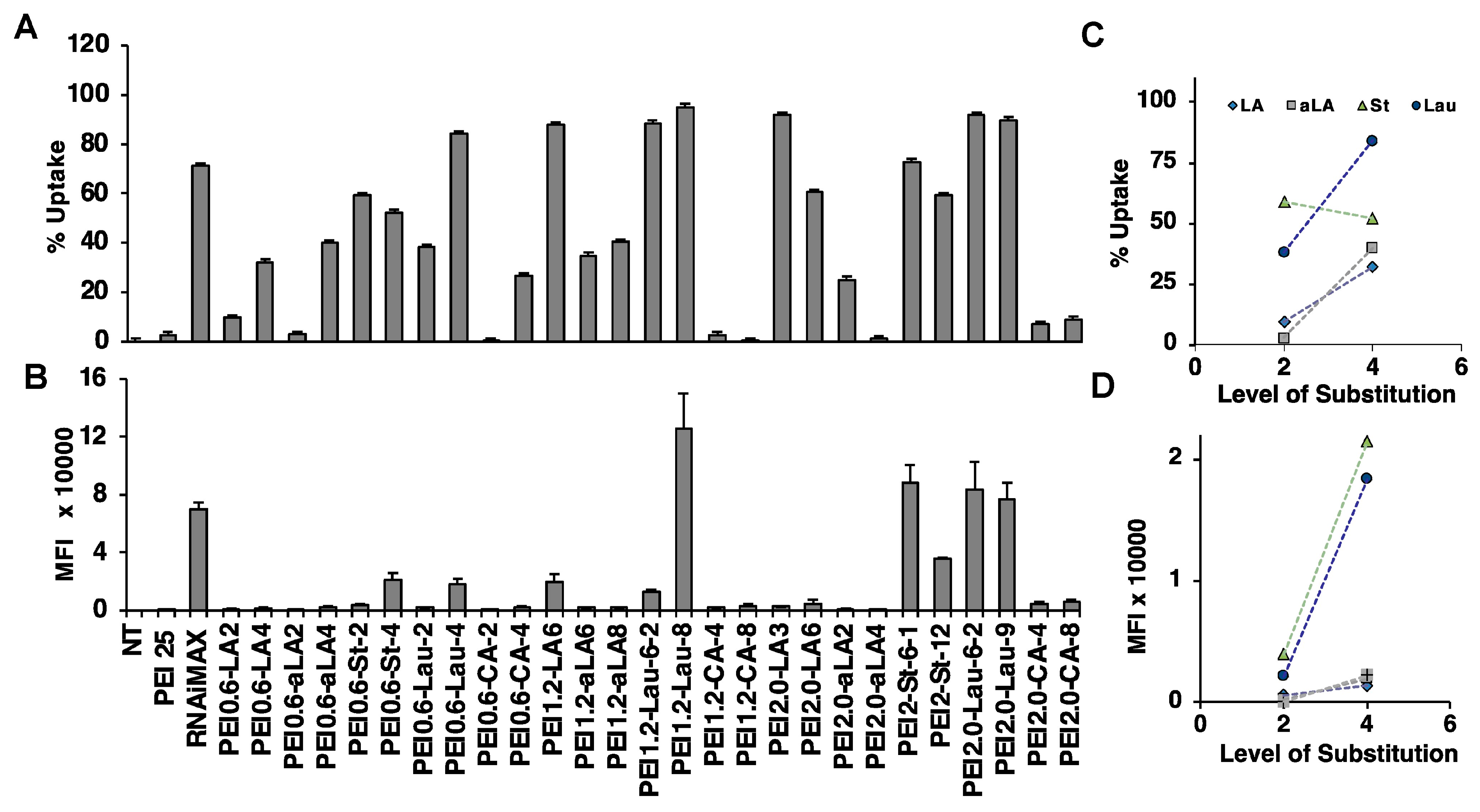

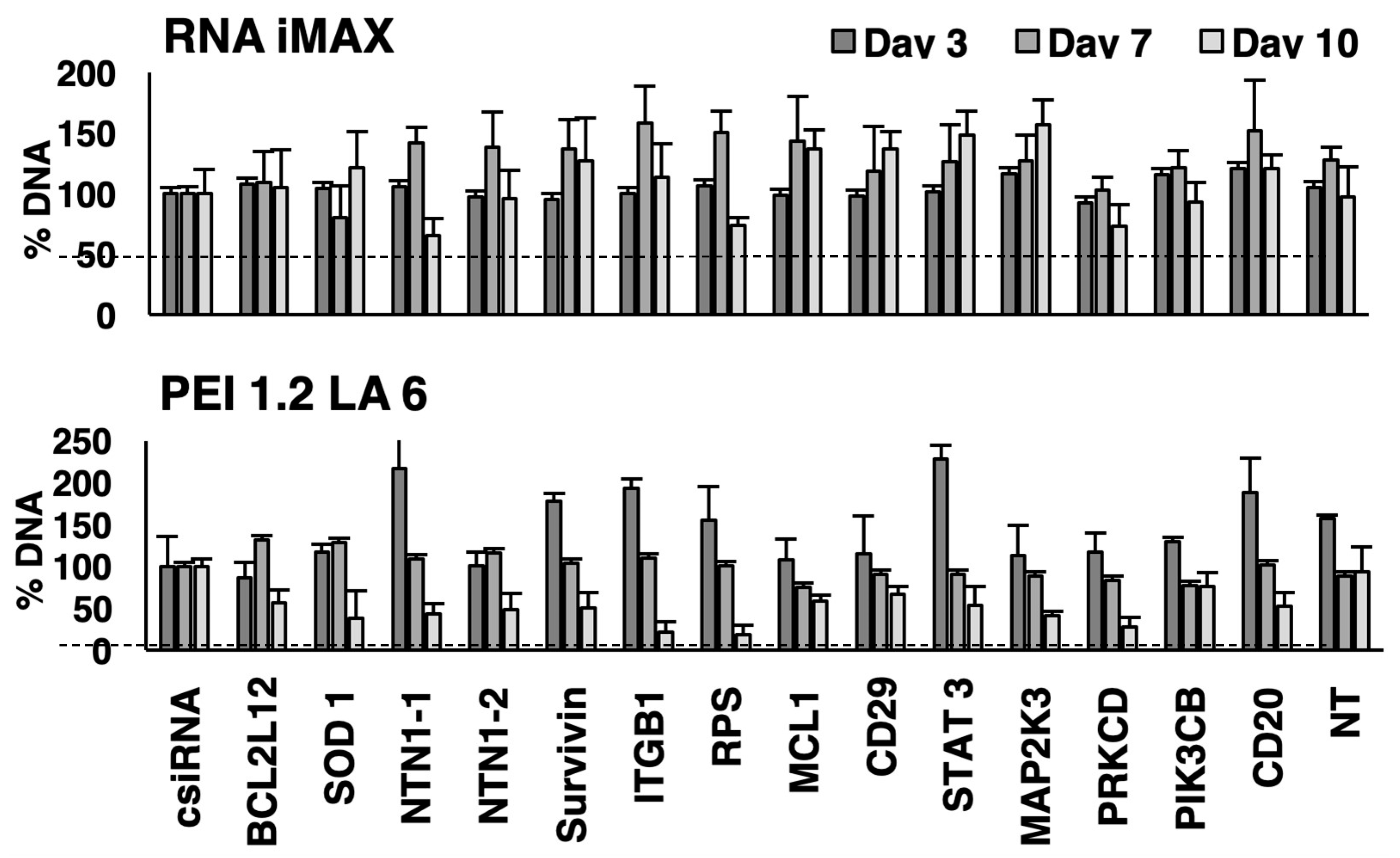
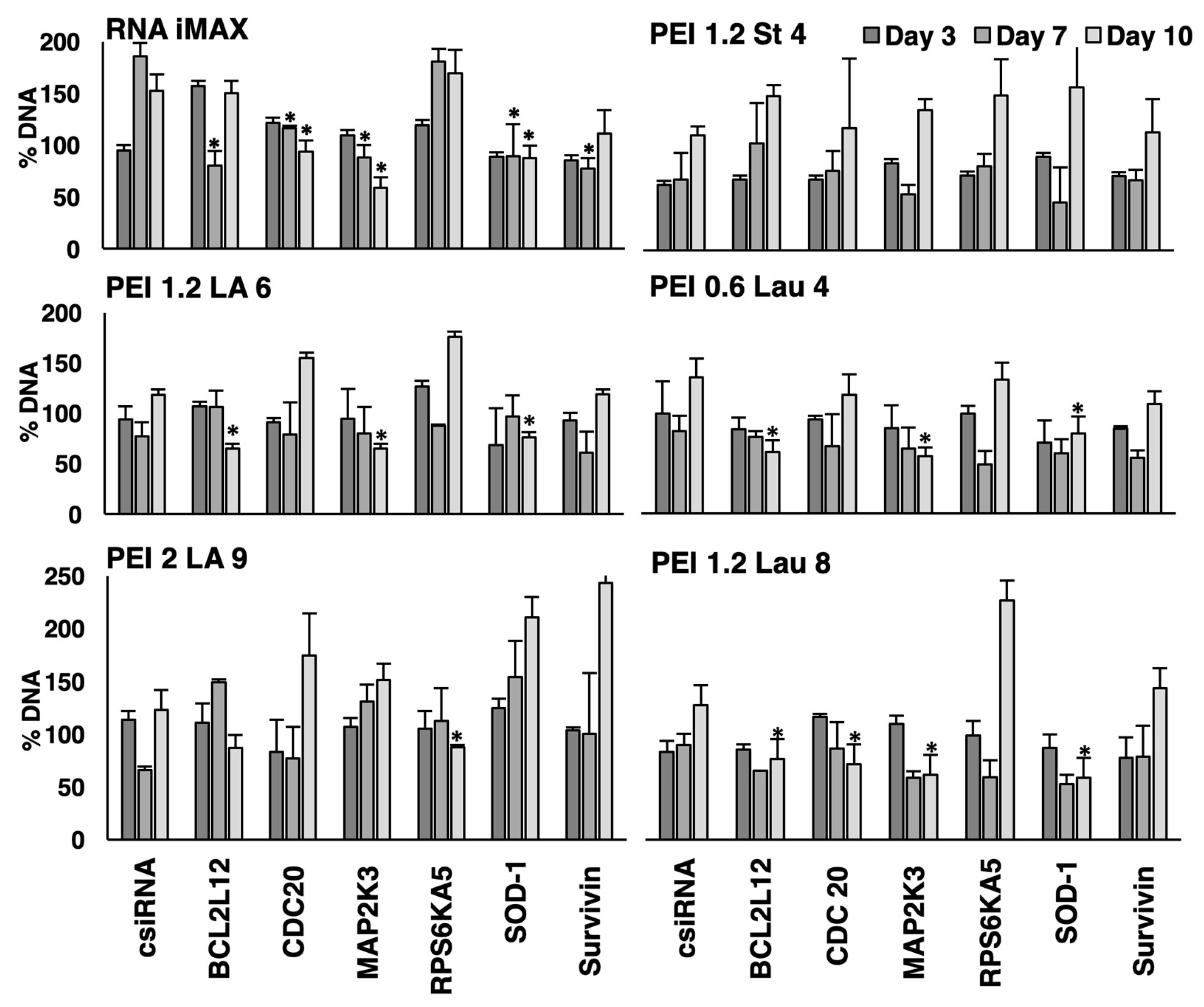

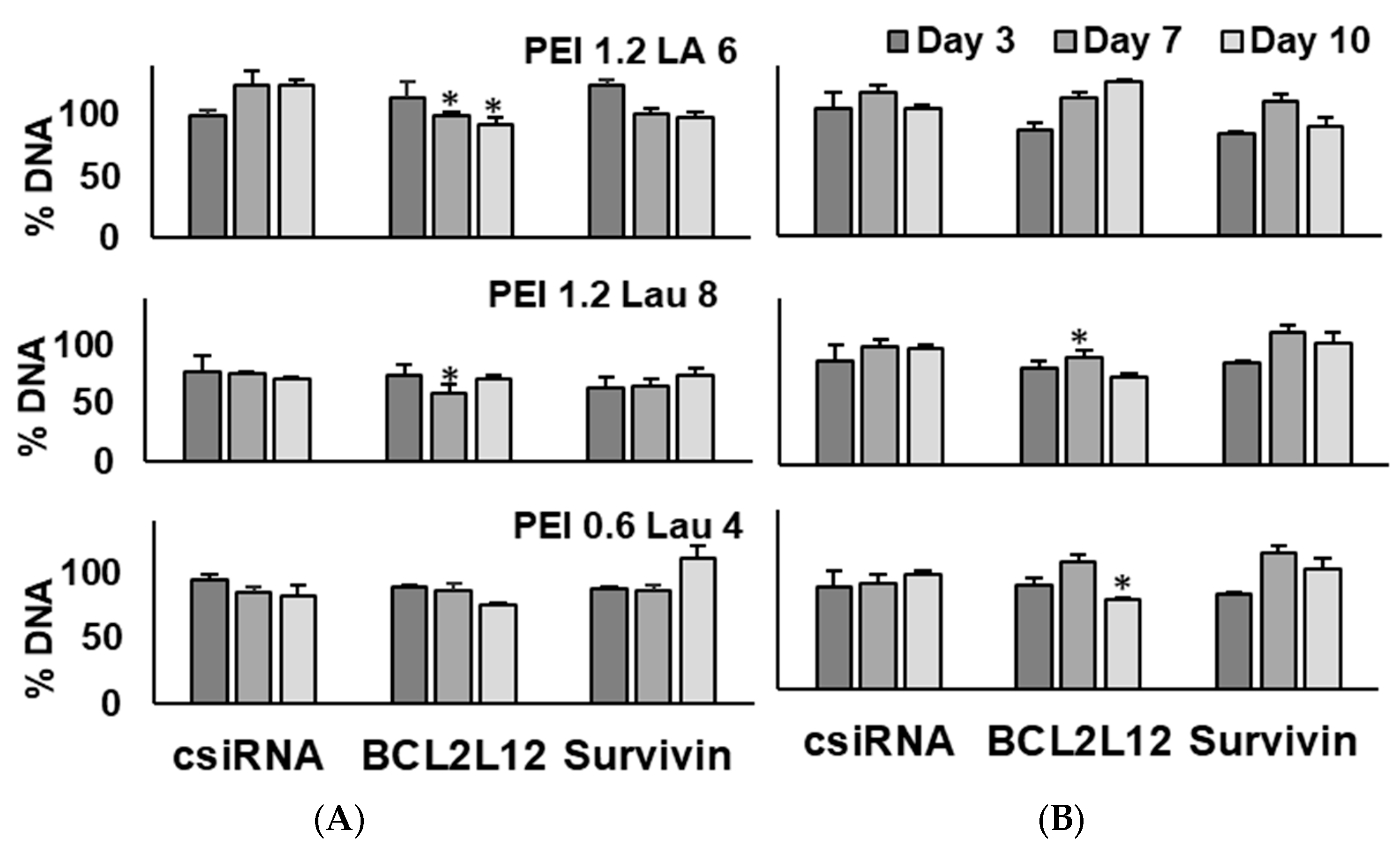

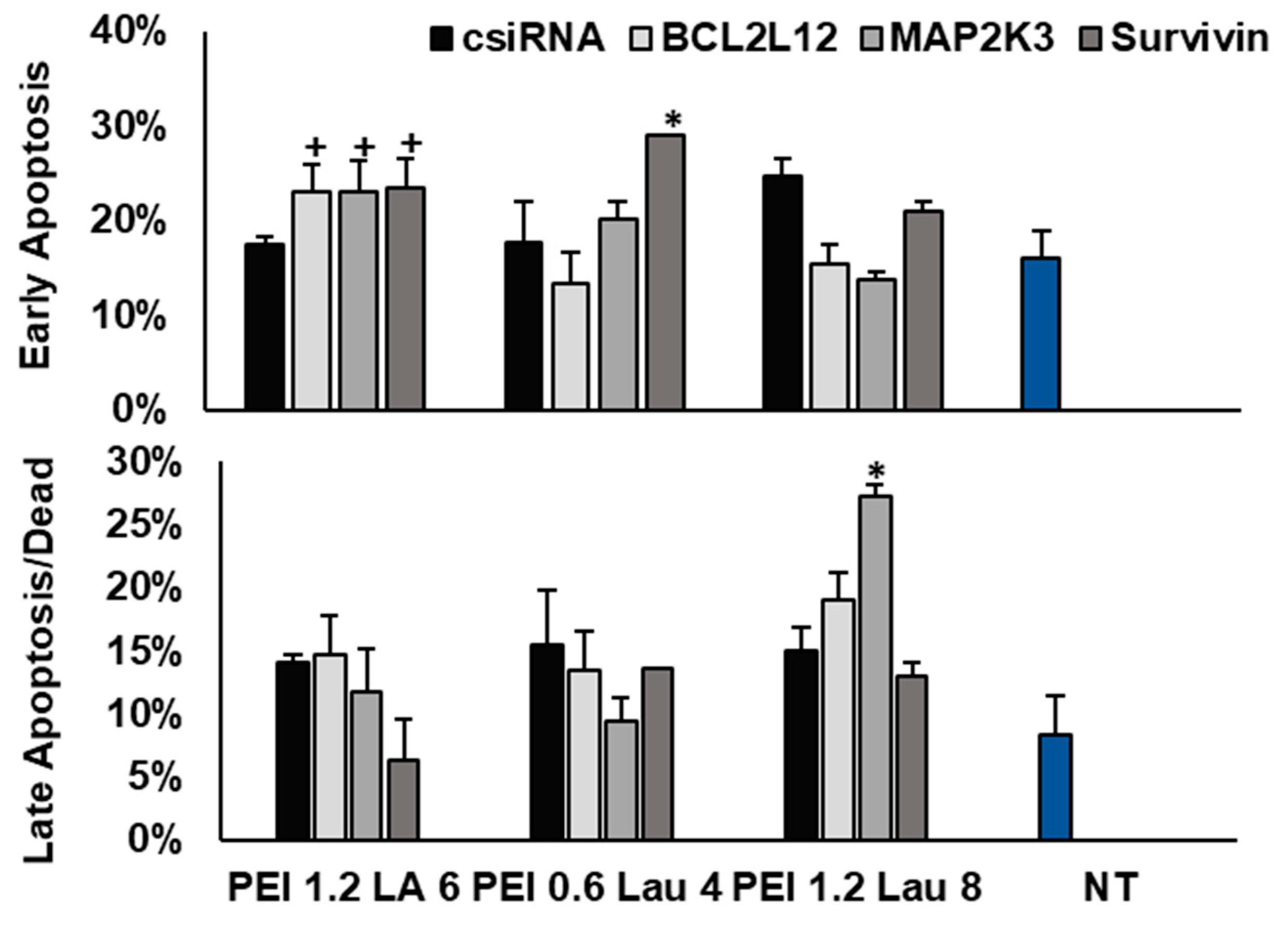
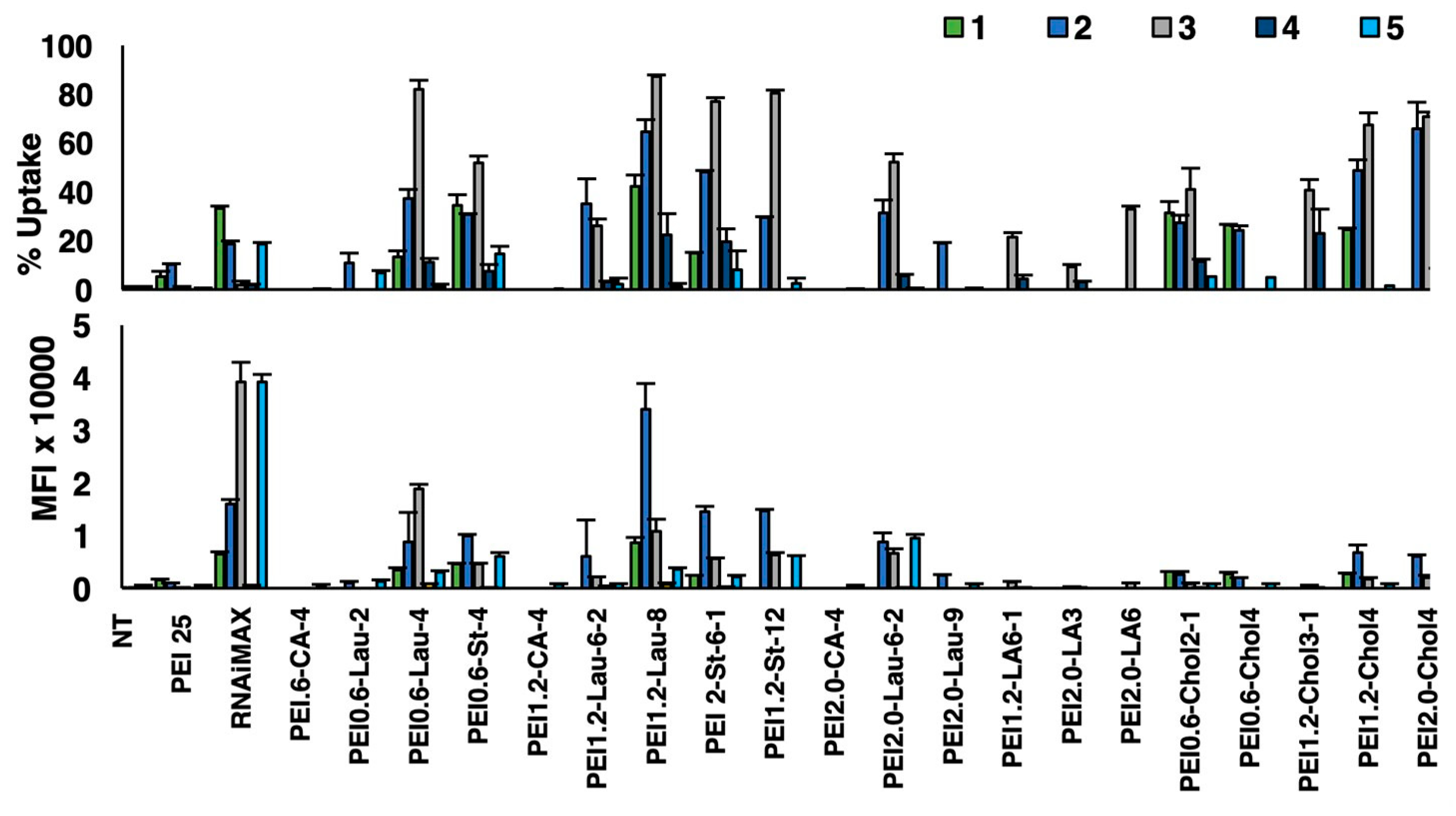
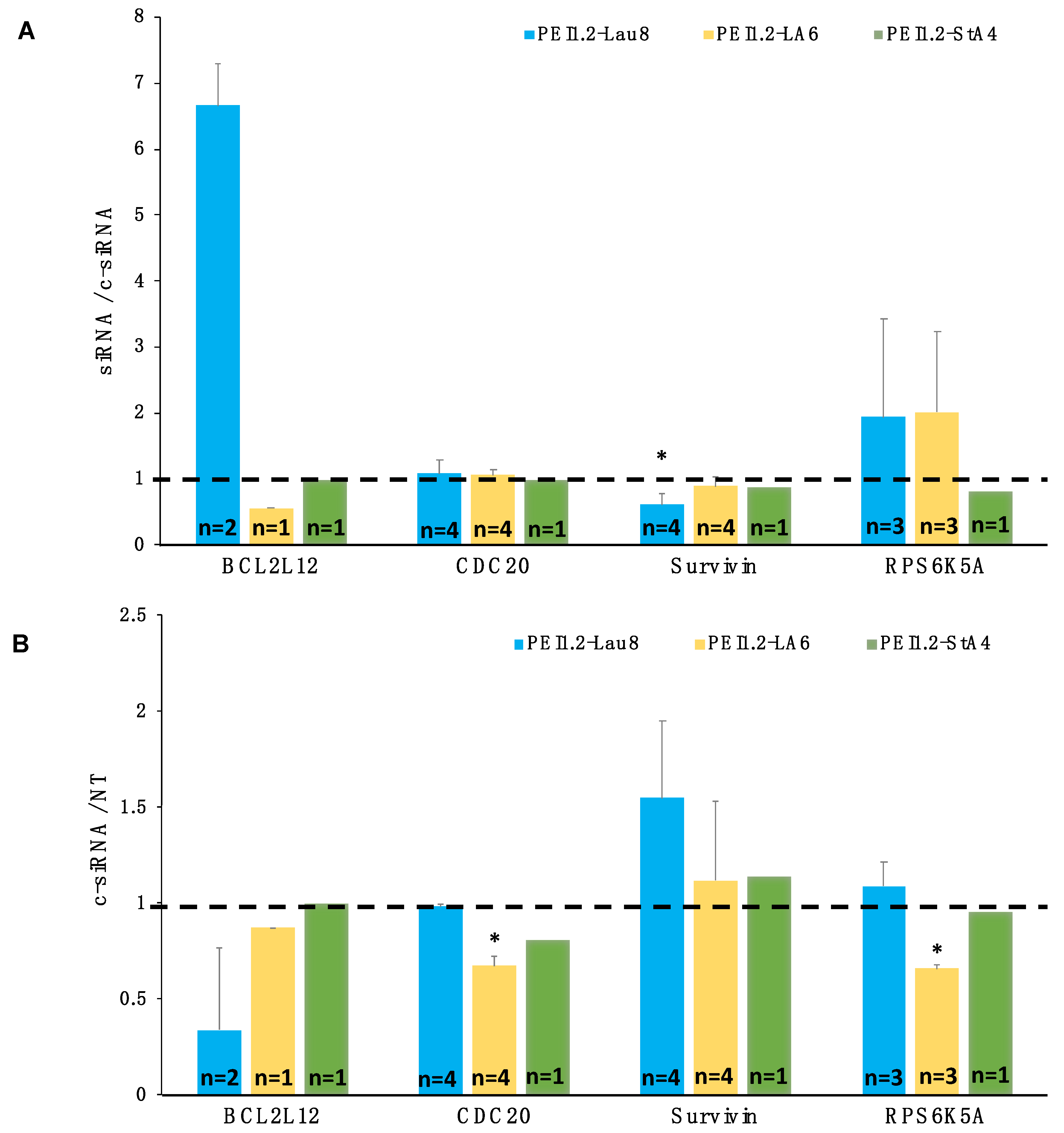
| BCL2L12 Forward | 5′ CCC GCC CCT ATG CCC TTT TT 3′ |
| BCL2L12 Reverse | 5′ ACC GGC CCA GCG TAG AA 3′ |
| CDC20 Forward | 5′ CGC TAT ATC CCC CAT CGC AG 3′ |
| CDC 20 Reverse | 5′ GAT GTT CCT TCT TGG TGG GC 3′ |
| MAP2K3 Forward | 5′ CGG CTG CAA GCC CTA CAT 3′ |
| MAP2K3 Reverse | 5′ CAG ACG TCG GAC TTG ACA TTG T 3′ |
| RSP6KA5 Forward | 5′ GAC ACT GCA GCC CAG CAA 3′ |
| RSP6KA5 Reverse | 5′ CCT AAG CTA CTG AGT CCG AGA ACT G3′ |
| SOD-1 Forward | 5′ GCA CAC TGG TGG TCC ATG AAA 3′ |
| SOD-1 Reverse | 5′ TGG GCG ATC CCA ATT ACA CC 3′ |
| Survivin Forward | 5′ TGA GAA CGA GCC AGA CTT GG 3′ |
| Survivin Reverse | 5′ ATG TTC CTC TAT GGG GTC GT 3′ |
Disclaimer/Publisher’s Note: The statements, opinions and data contained in all publications are solely those of the individual author(s) and contributor(s) and not of MDPI and/or the editor(s). MDPI and/or the editor(s) disclaim responsibility for any injury to people or property resulting from any ideas, methods, instructions or products referred to in the content. |
© 2023 by the authors. Licensee MDPI, Basel, Switzerland. This article is an open access article distributed under the terms and conditions of the Creative Commons Attribution (CC BY) license (https://creativecommons.org/licenses/by/4.0/).
Share and Cite
Ubeda Gutierrez, A.M.; Remant Bahadur, K.C.; Brandwein, J.; Uludağ, H. Exploring the Potential of siRNA Delivery in Acute Myeloid Leukemia for Therapeutic Silencing. Nanomaterials 2023, 13, 3167. https://doi.org/10.3390/nano13243167
Ubeda Gutierrez AM, Remant Bahadur KC, Brandwein J, Uludağ H. Exploring the Potential of siRNA Delivery in Acute Myeloid Leukemia for Therapeutic Silencing. Nanomaterials. 2023; 13(24):3167. https://doi.org/10.3390/nano13243167
Chicago/Turabian StyleUbeda Gutierrez, Anyeld M., K. C. Remant Bahadur, Joseph Brandwein, and Hasan Uludağ. 2023. "Exploring the Potential of siRNA Delivery in Acute Myeloid Leukemia for Therapeutic Silencing" Nanomaterials 13, no. 24: 3167. https://doi.org/10.3390/nano13243167
APA StyleUbeda Gutierrez, A. M., Remant Bahadur, K. C., Brandwein, J., & Uludağ, H. (2023). Exploring the Potential of siRNA Delivery in Acute Myeloid Leukemia for Therapeutic Silencing. Nanomaterials, 13(24), 3167. https://doi.org/10.3390/nano13243167








